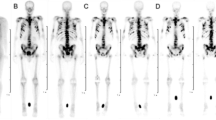Abstract
Strontium plasma clearance is an important factor determining the absorbed dose to metastases and bone marrow in patients receiving 89Sr radionuclide therapy for metastatic bone disease. Amongst male patients with disseminated prostatic carcinoma, the renal component of strontium clearance is frequently greatly reduced compared with values reported for healthy middle aged men. We report a study of renal and gut strontium plasma clearance, renal function, calcium urinary excretion, parathyroid function and extent of skeletal osteoblastic metastatic disease in patients referred for radiostrontium therapy for metastasised prostatic malignancy. The wide variation in net strontium clearance was principally due to variation in the renal component. Low values of strontium renal clearance were found to correlate with the elevation of serum PTH and nephrogenous cyclic AMP, which in turn correlated with extent of skeletal metastatic disease. This suggests that the osteosclerotic metastases characteristic of prostatic carcinoma induce secondary hyperparathyroidism due to the high avidity of the skeleton for calcium. The resulting reduction in strontium excretion may be beneficial to the objectives of radiostrontium therapy.
Similar content being viewed by others
References
Blake GM, Zivanovic MA, McEwan AJ, Ackery DM (1986) Sr-89 therapy: strontium kinetics in disseminated carcinoma of the prostate. Eur J Nucl Med 12:447–454
Blake GM, Gray JM, Zivanovic MA, McEwan AJ, Fleming JS, Ackery DM (1987) Strontium-89 radionuclide therapy: a dosimetric study using impulse response function analysis. Br J Radiol 60:685–692
Blake GM, Zivanovic MA, Blaquiere RM, Fine DR McEwan AJ, Ackery DM (1988) Sr-89 therapy: measurement of absorbed dose to skeletal metastases. J Nucl Med 29:549–557
Bradley JV (1968) Distribution-free statistical tests. Frentice-Hall, NJ Englewood Cliffs
Groadus AE, Mahaffey JE, Bartter FC, Neer RM (1977) Nephrogenous cyclic adenosine monophosphate as a parathyroid function test. J Clin Invest 60:771–783
Brown BL, Albano JDM, Ekins RP, Sgherzi AM (1971) A simple and sensitive saturation assay method for the measurement of adenosine 3′:5′-cyclic monophosphate. Biochem J 121:561–562
Comar CL (1967) Some principles of strontium metabolism: implications, applications, limitations. In: Lenihan JMA, Loutit JF, Martin JH (eds) Strontium Metabolism. Academic Press, London, pp 17–31
Firusian N, Mellin P, Schmidt CG (1976) Results of strontium-89 therapy in patients with carcinoma of the prostate and incurable pain from bone metastases: a preliminary report. J Urol 116:764–768
Harrison GE, Raymond WHA, Tretheway HC (1955) The metabolism of strontium in man. Clin Sci 14:681–695
Harrison GE, Sutton A (1967) Ratio of the faecal to urinary clearance of strontium in man. In: Lenihan JMA, Loutit JF, Martin JH (eds) Strontium Metabolism. Academic Press, London, pp 161–166
Kloiber R, Molnar CP, Barnes M (1987) Sr-89 therapy for metastatic bone disease: scintigraphic and radiographic follow-up. Radiology 163:719–723
Laing AH (1987) Strontium-89 therapy for skeletal metastases. Br J Radiol 60:732 (abstr.)
Lewington VJ, Zivanovic MA, Blake GM, Buchanan RB, Ackery DM (1988) Treatment of bone pain in disseminated prostatic carcinoma using strontium-89. Nucl Med Commun 9:179–180 (abstr.)
Linehan WM, Kish ML, Chen SL, Andriole GL, Santora AC (1986) Human-prostate carcinoma causes hypercalcemia in athymic nude-mice and produces a factor with parathyroid hormonelike bioactivity. J Urol 135:616–620
Marshall JH, Lloyd EL, Rundo J, Liniecki J, Marroti G, Mays CW, Sissons HA, Snyder WS (1973) Alkaline earth metabolism in adult man. Health Physics 24:125–221
Nordin BEC (1976) Calcium, phosphate and magnesium metabolism: clinical physiology and diagnostic procedures. Edinburgh, Churchill Livingstone
Pepper GM, Strashun AM, Goldsmith SJ (1984) Hypocalcemia in metastatic bone disease: metabolic and radionuclide studies of a case. NY State J Med 84:41–44
Robinson RG (1986) Radionuclides for the alleviation of bone pain in advanced malignancy. Clinics in Oncology 5:39–49
Silberstein EB, Williams C (1985) Strontium-89 therapy for the pain of osseous metastases. J Nucl Med 26:345–348
Smallridge RC, Wray HL, Schaff M (1981) Hypocalcemia with osteoblastic metastases in a patient with prostate carcinoma: a cause of secondary hyperparathyroidism. Am J Med 71:184–188
Tommaso CL, Tucci JR (1979) Metabolic studies in a case of hypocalcemia and osteoblastic metastases. Arch Intern Med 139:238–241
Urwin GH, Percival RC, Galloway J, Guilland-Cumming DF, Lawson-Matthew PJ, Williams JL, Kanis JA (1986) Endocrinology of disseminated prostatic carcinoma. Bone 7:305 (abstr.)
Author information
Authors and Affiliations
Rights and permissions
About this article
Cite this article
Blake, G.M., Wood, J.F., Wood, P.J. et al. 89Sr Therapy: Strontium plasma clearance in disseminated prostatic carcinoma. Eur J Nucl Med 15, 49–54 (1989). https://doi.org/10.1007/BF00253599
Received:
Issue Date:
DOI: https://doi.org/10.1007/BF00253599




